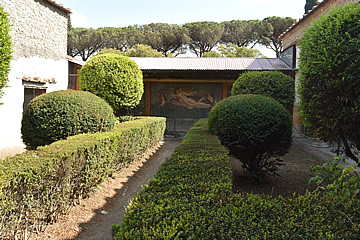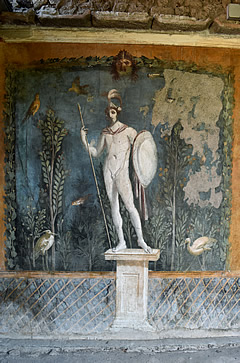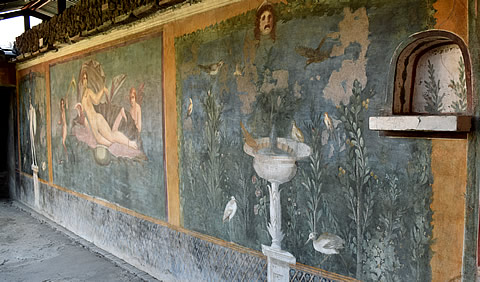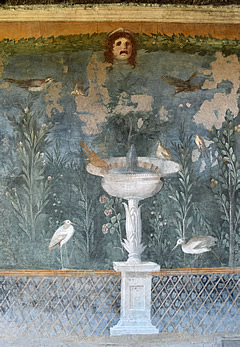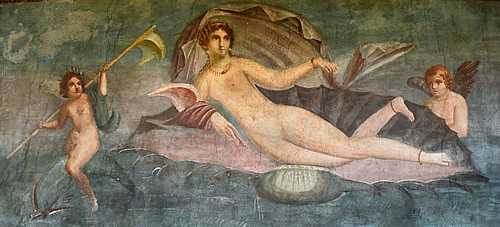

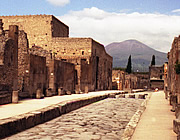
Pompeii is one of the most fascinating ancient sites in the world - it takes a long day to cover it in any depth. This first part looks at the region of the amphitheatre and palestra, workplaces and fabulous villas.
Related pages:
Pompeii Regiones V, VI & Villa dei Misteri
Pompeii Regiones VII, VIII
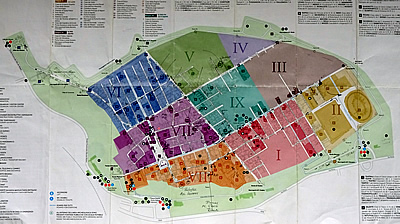
In 1998 we spent a good few hours exploring Pompeii, travelling from near Paestum where we were staying, and managed to see the major parts of the site but it was very hot and quite oppressive and we got very tired, especially as lunch time found us nowhere near the only restaurant on the site and returning to it involved visiting several villas, etc on the way in the interests of efficiency!
Returning in 2017 we stayed in the modern town of Pompei and spent six hours at the site. We were a lot more organised and saw a huge proportion of the town but it's just as well some of the houses were closed (almost always the case) or we might not have been so sensible and quit before we were exhausted.

The story of the eruption of Vesuvius in 79 AD which buried the town of Pompeii, preserving the scene for later archaeologists, is well-known. Though there had been earthquakes in the days preceding the cataclysmic eruption, these were not uncommon and it is not very surprising that many Pompeiians would carry on as normal.
Pliny the Elder, the famous naturalist, and at the time Commander of the Tyrrhenian fleet, was stationed in Misenum across the Bay of Naples. He, his nephew (also Pliny) and sister observed the eruption.
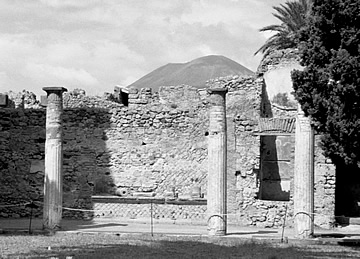
Intrigued, Pliny the Elder set sail for Pompeii, curious to investigate the unusual phenomenon, but also to try to save people from the eruption.
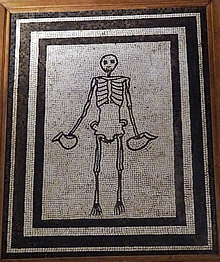 Mosaic of a skeleton with oil or wine jugs.
Found in Pompeii, now in the Naples Archaeological Museum.
Mosaic of a skeleton with oil or wine jugs.
Found in Pompeii, now in the Naples Archaeological Museum.As Admiral he was able to launch a number of ships. These were inundated with pumice as they travelled across the bay, and as they got closer to Pompeii the water became too shallow to proceed from all the material falling into the water. Instead they made for Stabiae and the villa of a friend of Pliny's. He was, however, not even safe there, and the following morning died as he and his friends tried to escape from the ferocious onslaught.
He had left his nephew, also Pliny, behind in Misenum and it is from Pliny the Younger that we have an eye-witness account, albeit written two decades later, to the historian Tacitus. Though Pliny's two letters are dated in August, there is some question as to whether it was not, in fact, later in the year. Dio Cassius, a historian writing at least a century after the event, is the main source of this dispute.1
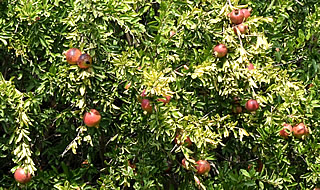

The argument turns on archaeological evidence of, for instance, agricultural activities at the time such as when the grape harvest could have been held - usually this would be later than August but not impossible for early varieties and a different climate 2,000 years ago; whether fresh walnuts, ripe pomegranates would have been available in late August, etc. We know that Pliny the Elder set off around 2pm - could he have made it across the bay before nightfall (as he did) later in the year? Is the fact that people were found wearing woollen clothing significant? Presumably heavier clothing provides more protection and with an ash cloud covering the sky it could have been colder than usual. I will stick to Pliny the Younger's dated letters for this account.
On the 24th August AD 79 something was already amiss in the morning, and some time around 1pm vast quantities of hot gas, ash, rocks and lapilli - small stones - shot out of the cone at a speed of hundreds of feet per second, reaching an altitude of between 65,000 to 1000,000 feet.1


Lighter particles travelled faster and further to fall on Pompeii within a couple of hours, to be followed by heavier particles later, and Pompeii was buried under a 6 metre layer of lapilli and pumice.
Unable to sustain itself the column of volcanic material collapsed temporarily around 3pm, falling on the sides of the volcano to flow down in a pyroclastic flow of fast-moving, superheated gas, mud and lava which inundated Herculaneum.1,2 There seems to have been some respite for Pompeii at this time, though there was earthquake activity and fires on the slopes of the volcano. The following day, however, the magma chamber collapsed causing surge after surge of pyroclastic flows.1
Though the walls of Pompeii withstood the first onslaught, the city eventually succumbed to the ferocious final stages of the eruption. Most of the population had already left, but around 3,000 people perished, and some of the most poignant remains are the casts taken of the cavities left after the bodies, buried by the ash and pumice, had decayed away.
 Bakery Complex in Regio VI, Insula 14.
Bakery Complex in Regio VI, Insula 14.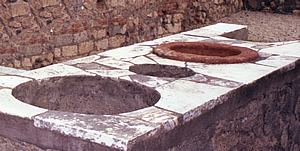
Pompeii had not grown organically but was planned on an orderly grid system of streets, with the imposing Forum and majestic temples and civic buildings at its heart, all surrounded by a substantial wall with many towers. Even in its origins in the 6th century BC, when the settlement was just a village, it was laid out on a grid system and surrounded by a wall.1 Today the town is labelled according to districts called Regio, of which there are 9, and these are further subdivided into a number of insula corresponding to a block of buildings bounded by roads.


Like Herculaneum and Roman Villas in the region, Pompeii had suffered in the earthquake of 62 AD and restoration work was still going on. Nevertheless, this was a prosperous, busy town, with shop-lined streets, food stalls, public baths, and many residential properties, from large opulent many-roomed dwellings of the rich to single rooms attached to shops, either behind or above - many of the buildings had two storeys. In the south were two theatres and in the south eastern Regio II the huge palaestra and amphitheatre where the games were held. Necropoli were outside the town walls, often along major roads.

Walls were scrawled with graffiti on a diverse range of subjects, from the simplest so-and-so was here, to electioneering, boasts of sexual prowess and announcements of events such as gladiatorial games. The electioneering graffiti was erased and replaced yearly as new elections took place so we know that what we see now dates from around the time of the eruption.
Interiors of many buildings, especially the richer residences, are decorated with elaborate painted walls. In 1882 painting was classified into four chronological styles by August Mau, a German archaeologist.1
The First Style from the 2nd century BC. imitates marble in rows of brightly painted panels.
At the end of the 2nd century AD a new style develops, the Second Style, typified by architectural elements such as columns framing a view of landscapes or artwork.
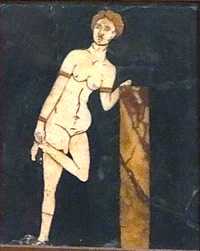
The Third Style, between 20 BC and AD 40-50, was strikingly different from what had gone before. Walls were now divided into three zones, upper, middle and lower. The middle zone was composed of large rectangular panels separated by elegant designs of architecture or vegetation. Figures began to make an appearance as well as Egyptian imagery.
Finally the Fourth Style emerged around the middle of the first century AD. It is much more complex, with two main strands: the first covers the whole wall and includes architecture, wide landscape views and full-length figures; the second develops from the Third Style with pictures centred in panels - it is this latter of the two forms seen most often in Herculaneum and Pompeii.
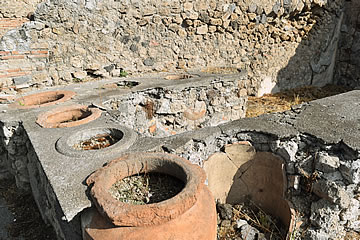
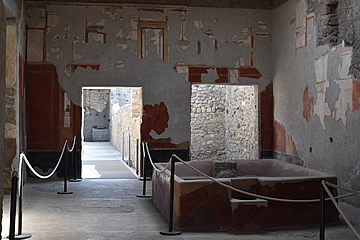
La Città Commerciale is the name the guide map gives to this region of Pompeii, but in truth, there is barely any part of the town which doesn't have signs of commerce. Every street of any size is lined with shops - well over 600 have been counted.1 Many so-called thermopolia have been discovered, easily identifiable by the holes in the counters and inset dolia which held foodstuffs. They sometimes also had a hearth over which a pot could be placed for hot food or drink.
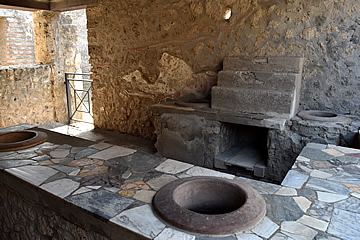
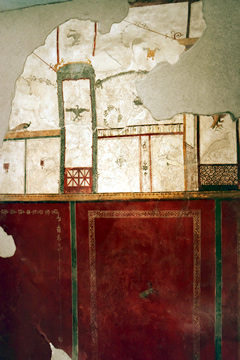
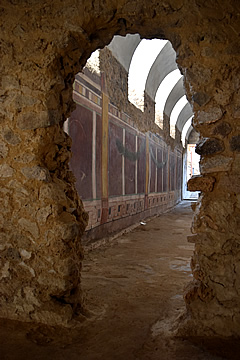
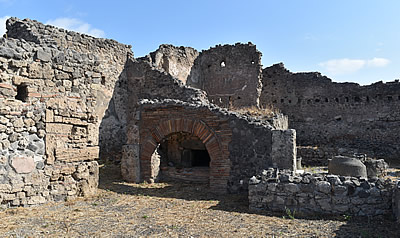
Due to its position at the mouth of the Sarnus, Pompeii was in a very favourable spot to profit from the transport and trade of goods. Ships could dock easily and with a well-developed road system Pompeii became a hub of commerce. There are many fine houses, testament to the wealth of some of its citizens.
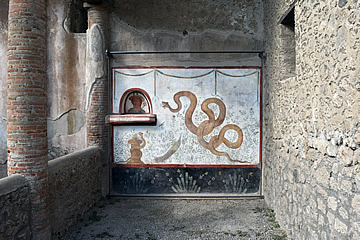 Casa del Criptoportico
Casa del Criptoportico
Casa del Criptoportico is enormous and much of its beautiful decoration has been preserved.
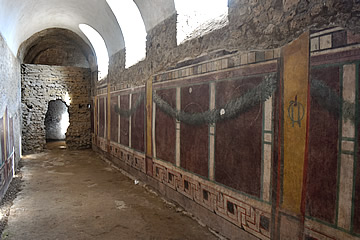
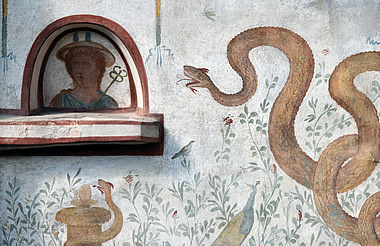
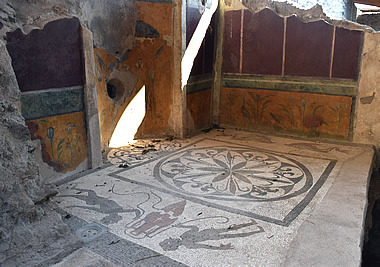
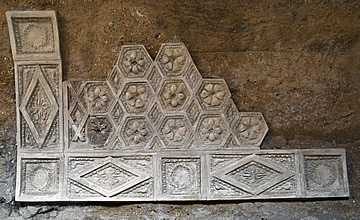
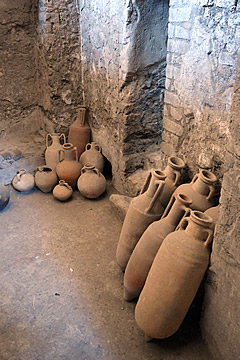
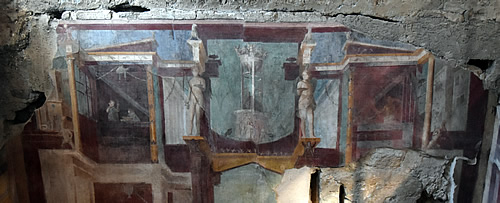
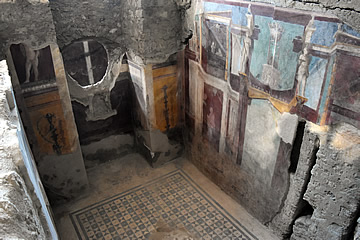
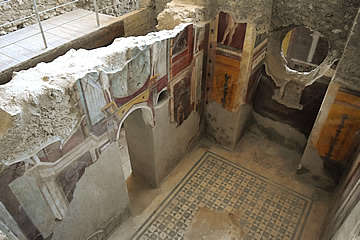
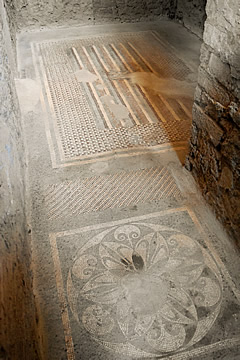
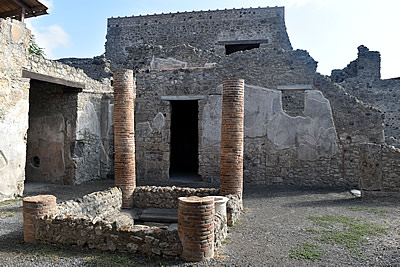
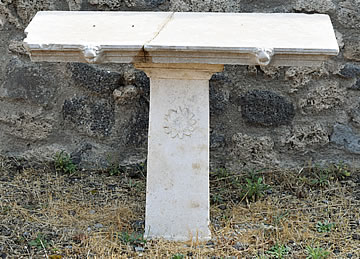
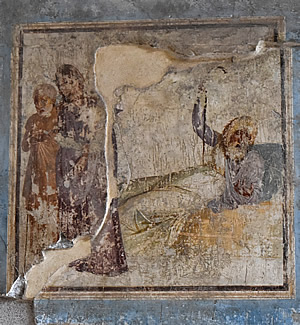
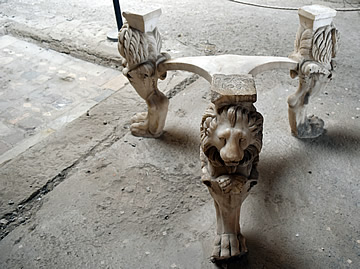
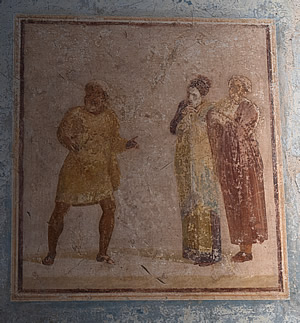
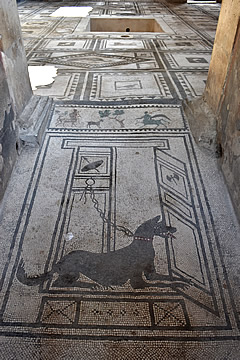
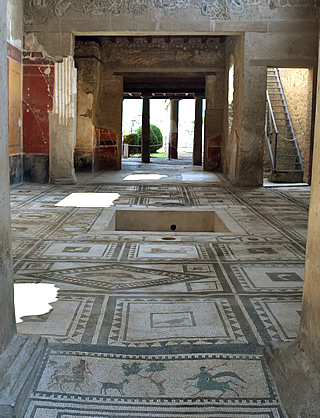
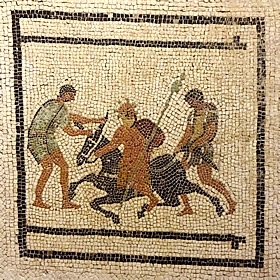
The most magnificent mosaic flooring to have survived virtually intact has to be in the Casa di Paquius Proculus - it also has a beautiful mosaic of a dog in the entrance, a common motif.
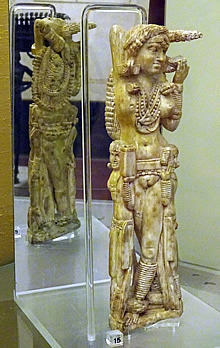
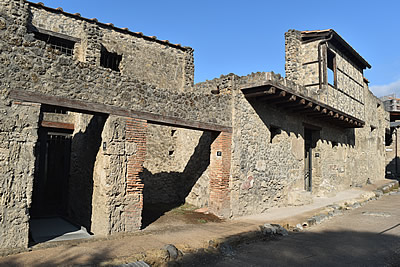
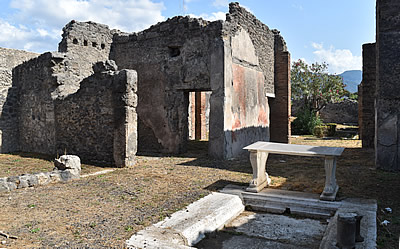
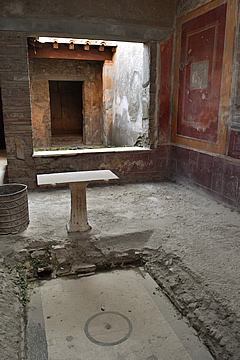
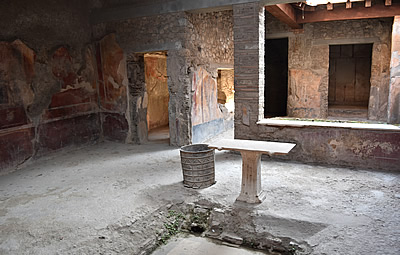
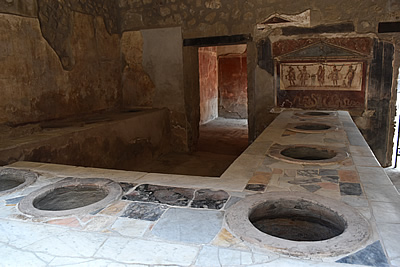
On the corner of Via dell'Abbondanza and an unnamed vicolo running south is one of the best-preserved thermopolia, that of Vetutius Placidus. It had a U-shaped marble bar counter with eleven inset dolia, some still containing food, and a hearth. On one wall is a painted lararium. Most citizens would eat away from home at one of the many bars in the town. Customers could also eat in rooms within the bar.
One of the most evocative finds was discovered here: 1385 bronze coins, mostly small denominations, representing perhaps a few days takings of the bar. In all probability the owner hid his money in the dolia hoping to recover it when he returned.
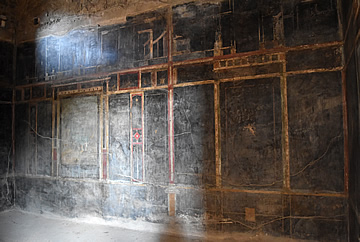
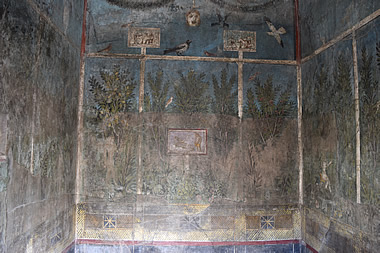
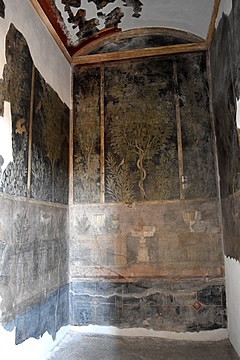
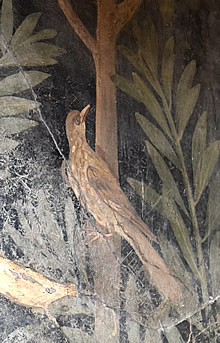
Casa dei Cubicoli Floreali has some of the most intact wall paintings in the fashionable Fourth Style. The garden paintings are particularly lovely.
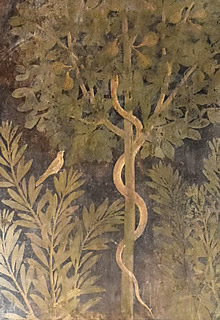
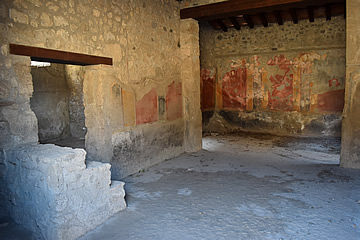
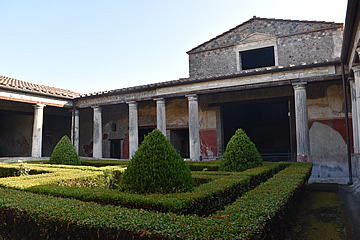
Casa del Menandro is another large opulent, residence - actually it's huge with over fifty rooms and a large peristyle garden. It occupied over three quarters of Insula 10, its ground floor covering 1800 sq m.4
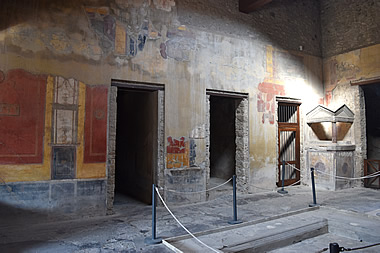
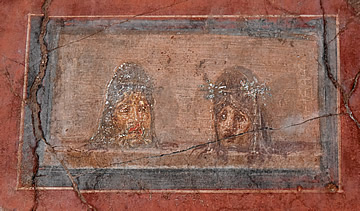
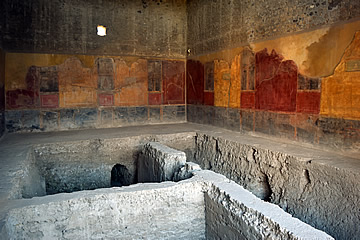
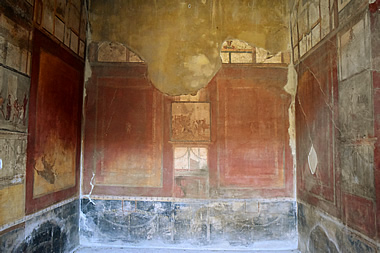
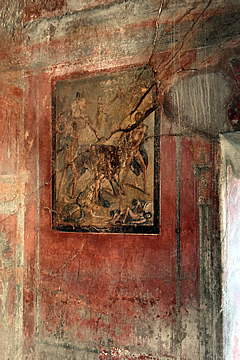
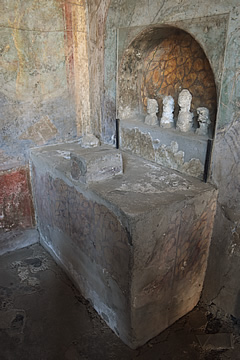
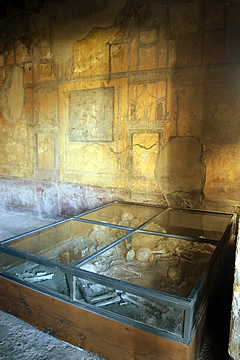
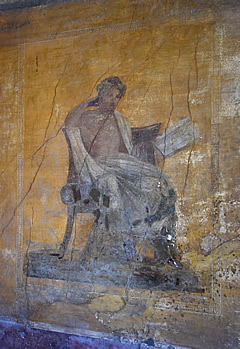
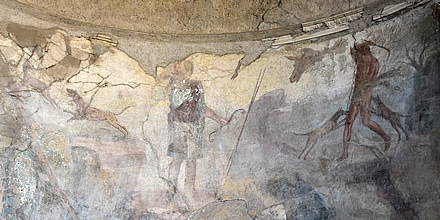
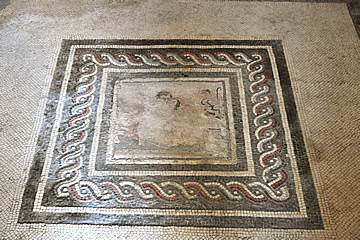
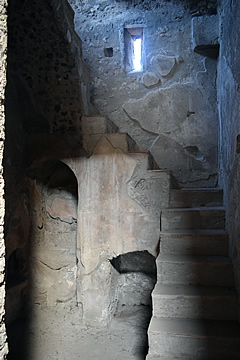
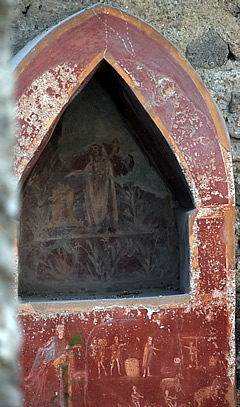
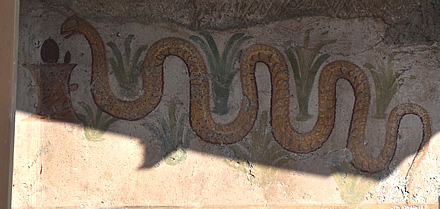
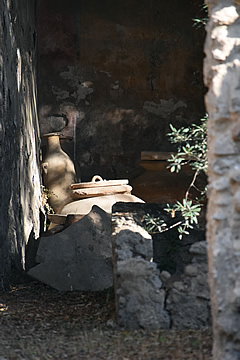
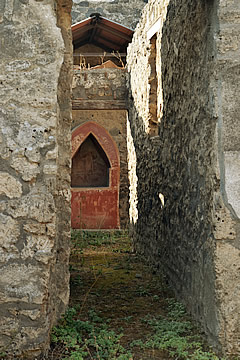
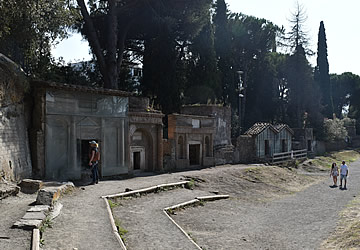
Regio I is separated from Regio II by the Via di Nocera which leads north from the Porta Nocera, one of the city gates.
The outskirts of Roman towns were typically the areas where tombs and necropoli were located, very often near city gates or lining entry roads. Pompeii was no exception and many necropoli can be seen outside the city walls. On the south side of the city in the Regio I area west of the Porta Nocera and east of the Porta di Stabia is an extensive necropolis.

The City in Green - the area devoted to sports and sporting entertainments. Here is the large amphitheatre where entertainment was predominantly gladiatorial combat, though animal "hunts were also popular.1
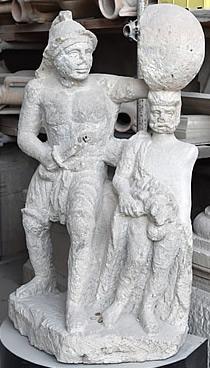




Built around the middle of the first century BC1 the amphitheatre at Pompeii is the oldest known. Its seating capacity was probably around 20,000, big enough to host Pompeiians and visitors from nearby towns. Tacitus recorded a riot here in 59 AD between the Pompeiians and the Nucerians who had come to watch the gladiatorial games, ending with many of the Nucerians dead or injured. As a consequence the Roman senate (Pompeii was a Roman colony at the time) closed the amphitheatre for ten years.1 A fresco of the event was found in Pompeii in the nineteenth century excavations.
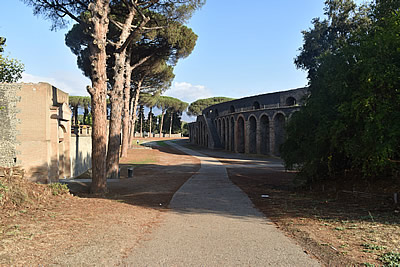
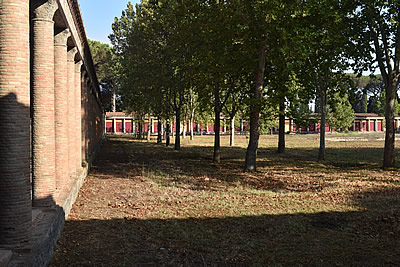 The Great Palaestra.
The Great Palaestra.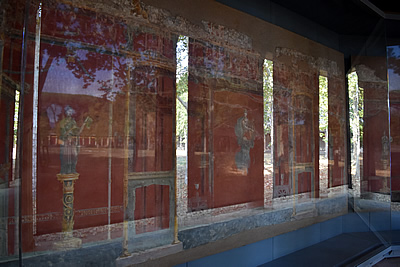 Frescoes from Moregine on display in the Great Palaestra.
Frescoes from Moregine on display in the Great Palaestra.
Alongside the amphitheatre is the Great Palaestra, built during the reign of Augustus, around the beginning of the first century AD, when Pompeii was still a Roman colony. It is enormous, approximately 140m by 107m, with colonnades on three sides and a large pool in the middle, 34m long by 22m wide. The pool sloped from a depth of about 1m to 2m.
The palaestra was a kind of gymnasium or training ground, originally particularly for wrestling.
During our visit there was an exhibition here of excavated treasures from the site of Moregine, south of Pompeii.
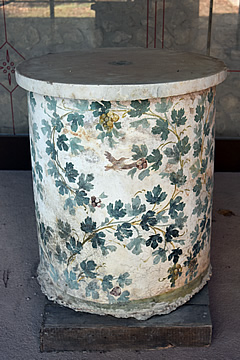
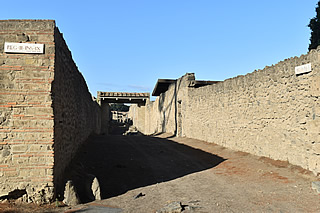
Regio II has its share of luxurious houses, one of the largest in the whole city is located here - the Casa di Giulia Felice. It occupies the whole of Insula 4 with entrances on all sides of the insula, a huge garden and a full baths complex.
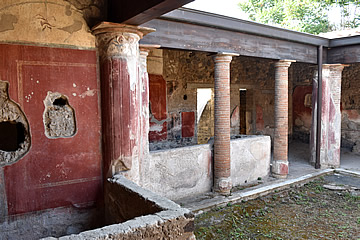
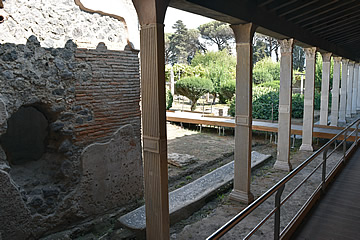
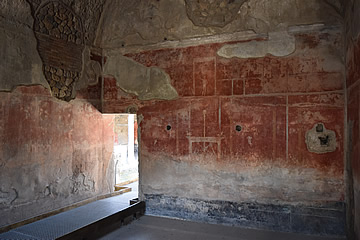
Giulia Felice (fortunate one) was obviously a wealthy woman. It seems her large villa was badly damaged in the earthquake of 62AD and she resorted to opening her extensive baths to select clients. She was quite the businesswoman, especially for the times. Not only did she rent out the baths complex, she also offered five year leases on other properties such as apartments and shops.1
The main entrance of the house is on Via dell'Abbondanza and leads directly into a columned portico and from there to the baths - rather an unusual arrangement for a villa but practical if you are allowing access for commercial purposes.
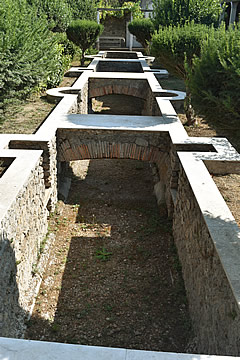
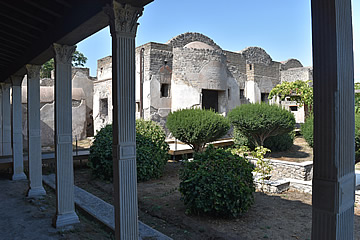
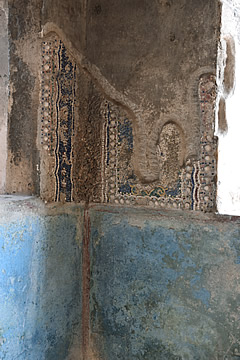
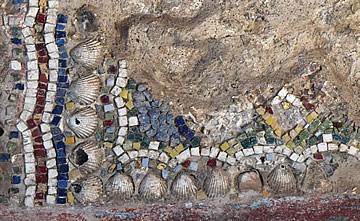
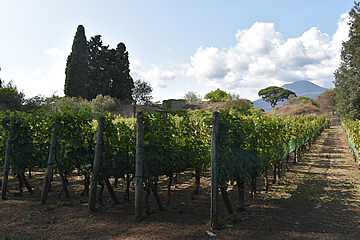
In Insula 3, just to the west of Casa di Giulia Felice, is another fine property, this with beautifully preserved frescoes - Casa della Venere in Conchiglia.
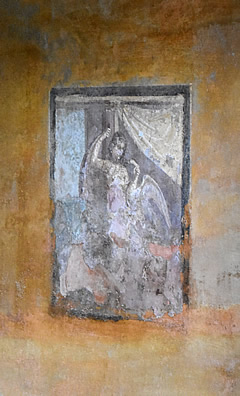
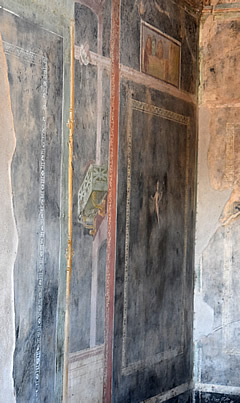
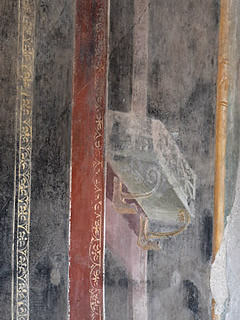
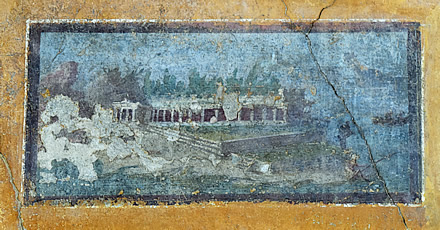
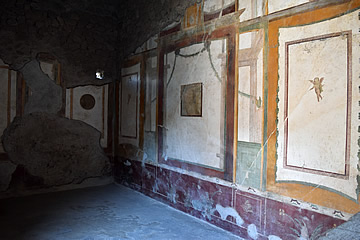
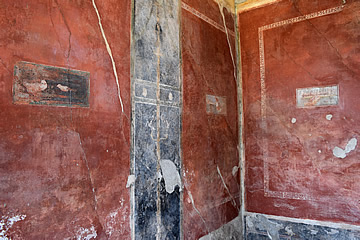
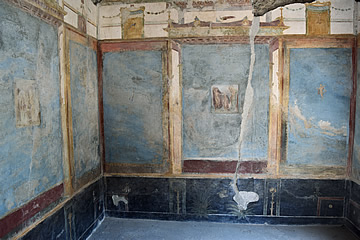
The showstopper is in the peristyle garden - the painting of La Venere in Conchiglia (Venus in a shell) on the south wall.
